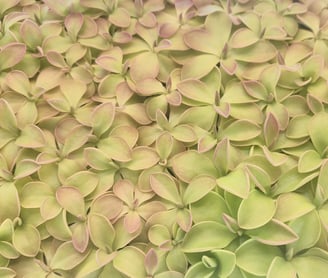Tropical and Mexican Butterwort Care Guide


LIGHTING
Does best in medium to high light. Bright direct light will produce a more colorful and compact plant. Medium-low light will suffice but your plant will develop larger greener leaves. Pale light green leaves that are stretched and drawn out with no dew are a sign that your plant is not receiving enough light.
We grow most of our pings 1-2 feet away from grow lights and achieve sufficient coloration. We suggest growers start with their plants around 2 feet away from their light and gradually move their plants closer until desired results are achieved. Sunny windowsills are also a great option or suppliment for pings.
SOIL & MEDIA
Does best in a gritty mix composed of 2-4 parts grit to 1 part sphagnum peat moss or vermiculite. Grit can include a wide range of mediums most commonly perlite, pumice, sand and crushed lava rock. Pings grown in typical indoor conditions should have a higher ratio of peat moss / vermiculite to absorb and retain more water. Pings grown in humid conditions or pings that receive frequent overhead watering should be grown with a higher proportion of grit as this loosens the media and holds onto less water.
A simple mix for most growers would be 2 or 3 parts perlite to 1 part sphagnum peat moss. Ensure the media is free of fertilizers and additives.
Many species prefer a alkaline mix with a high pH. This can be achieved by adding small amounts of crushed coral, ground oyster shells, ground egg shells or dolomite lime. While many species appreciate this and growers have report great results, this is not necessary and can be skipped if you wish.
WATER
Does well in consistently damp soil. The simplest way to achieve this is to bottom water using the tray method. This can be done by placing the potted ping in a tray or container and filling it with a few centimeters of water (around 20-30% of the way up the pot is a good guideline). Once the resevoir of water dries up, top up the tray after 0-5 days. Pings don't mind drying up a little bit so you don't need to stay on top of this.
Pings, like most carnivorous plants, do not handle hard water well and will require distilled, reverse osmosis or rain water if your tap water is high in minerals. This can be tested using a TDS pen (here). We want to shoot for a TDS reading of under 50ppm. Beyond that minerals can start to buildup in the soil and tray damaging the roots and causing your plant to struggle or even die.
For dormant pings we want to reduce watering and keep the soil on the drier side. A good rule of thumb is pings with tighter, smaller leafed rosettes such a P. gypsicola or the bulb-like heterophylla and macrophylla require bone-dry conditions. Species with larger winter leaves like P. moranensis and agnata do fine slightly damp.
FEEDING & FERTILIZATION
Feeding is NOT necessary for plant survival, however it will promote faster growing and larger plants. You can view caught insects as added fertilizer for the plant. Liquid fertilizer can be lightly spritzed over the plant monthly at one quarter the recommended dose. We offer fertilization options here.
TERMPERATURE & HUMIDITY
Pings can tolerate a wide range of temperatures and humidity levels. They grow well in temperatures between 10-32°c (50-90°f) and humidity levels from 40-95%. These plants will do well in most household environments, including outdoor greenhouses and terrariums. Pings grown at high humidity levels should have good air circulation and proper drainage.
DORMANCY
Mexican or Tropical butterworts have a winter dormancy that is marked by a change in their leaves from carnivorous and dewy to a tighter, non-carnivorous, more succulent leaf. When the Pinguicula has formed these tight, succulent leaves you can withhold water as described above for the dormancy period. We wait for the butterworts to go dormant before we stop watering. And when they begin growing their carnivorous leaves we begin the tray method of watering again.
